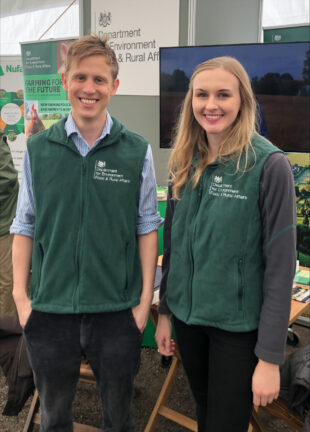https://defrafarming.blog.gov.uk/sow-winter-bird-food-plots-in-autumn/
Sow winter bird food plots in autumn
The guidance on this page is for SFI pilot participants only. Please visit GOV.UK for the official Sustainable Farming Incentive scheme guidance.
Find out how land managers can feed farmland birds in winter by establishing autumn-sown bird food plots on arable land.
If you’re completing this action as part of the Sustainable Farming Incentive pilot, how you do it is up to you.
The advice on this page can help you get better environmental and business benefits, but you do not have to follow it to get paid.
Winter bird food plots
Winter bird food plots are areas of sown seed-bearing crops that are left unharvested over winter. They provide:
- a reliable food source for seed-eating farmland birds in winter
- shelter for birds, insects and mammals throughout the year
- invertebrate food (like worms and snails) in spring and summer for birds like thrushes
- a place for annual arable wildflowers to grow, flower and set seed
If possible you should sow winter bird food plots in the spring, so that you provide seed every winter. At least half of the total area of winter bird food plots on your land needs to be spring-sown.
You can sow in the autumn if spring-sown plots are difficult to establish due to:
- regular spring droughts and higher soil moisture in late summer than in spring
- heavy soil, so you cannot create a suitable seedbed until late spring
You’ll need to spread seed in the first winter after establishment. Autumn-sown plots do not provide any seed in the first winter and you need to replace that food source.
To maintain or increase bird populations, you also need to give birds year-round food sources alongside winter bird food plots.
Choose your location
The best locations are fertile and:
- sunny and south or south-west facing, as shady sites can lead to poor establishment and yield
- weed-free, as too many weeds will affect crop establishment
- near to nesting, roosting and other feeding habitats, where possible
Put your plots near to hedges or scrub to give birds shelter from predators.
Avoid sites:
- which are difficult to get to and manage, like remote field corners
- next to public highways or public rights of way, as regular disturbance stops birds from feeding
- within 5 metres of watercourses if you plan to use insecticides
You can move plots to fit your rotation and reduce the build-up of weeds, pests and diseases.
What to sow
You must use organic seed if you farm organically or are converting to organic farming. You’ll need approval from your organic certification body to use non-organic seed.
You can sow either a 1 year seed mix or a 2 year seed mix. Both will provide food for a range of farmland birds.
Example of a 1 year seed mix
Sow this seed mix every year at 70kg per hectare (kg/ha).
| Crop species | Seed rate, kg/ha |
|---|---|
| Winter wheat | 25 |
| Winter barley or winter oats | 15 |
| Winter triticale | 15 |
| Winter linseed | 8 |
| Gold of pleasure | 3 |
| Fodder radish | 2 |
| White mustard | 1 |
| Brown mustard | 0.5 |
| Phacelia | 0.5 |
If there are corn buntings on your land, you can adapt this mix to provide seed for them. For corn buntings:
- increase the proportion of cereals
- sow it on a 4 to 5 inch row spacing, as corn buntings prefer a denser plot
- sow in large, wide blocks at least 0.4ha and 48 metres wide
Example of a 2 year seed mix
Sow this seed mix every 2 years at 70kg/ha.
| Crop species | Seed rate, kg/ha |
|---|---|
| Winter wheat | 25 |
| Winter barley or winter oats | 15 |
| Winter triticale | 15 |
| Winter linseed | 8 |
| Gold of pleasure | 2 |
| Kale or stubble turnip | 2 |
| Fodder radish | 1 |
| White mustard | 1 |
| Brown mustard | 0.5 |
| Phacelia | 0.5 |
Kale or stubble turnip should produce seed in the third winter after establishment. Check plots during the second winter as kale can set seed early. If it has seeded in the second winter, you can either:
- re-establish the plot in the following spring or autumn
- broadcast (scatter) mustard, fodder radish and millet into the existing plot from May
This seed mix is good for grey partridges. Plots for grey partridges need to be in open areas away from woodland. The second year can also provide good chick rearing habitat.
Create your own seed mix
You can adapt the example seed mixes. Your seed supplier can help you create a seed mix to best match your land and local conditions.
You need to sow at least 6 different crops from at least 2 different crop groups, to provide food for a range of birds. The crop groups are cereals, brassicas and oilseeds.
Suitable cereal crops for autumn-sown plots are winter:
- barley
- wheat
- triticale
- oats
Make sure that the combined seed rate in kg/ha of cereals does not exceed 70% of the total seed rate.
Suitable oilseed and brassica crops for autumn-sown plots are:
- winter linseed
- gold of pleasure
- fodder radish
- mustard
- kale
- forage rape
- stubble turnip
Companion flower species
You can add flower species to your seed mix to provide a source of pollen and nectar.
Keep the seed rate of flowers low to stop them outcompeting your seed producing crops.
| Crop species | Maximum seed rate, kg/ha |
|---|---|
| Common vetch | 2 |
| Borage | 1 |
| Crimson clover | 1 |
| Black medick | 0.5 |
| Phacelia | 0.5 |
| Red clover | 0.3 |
| Sweet clover | 0.3 |
| Chicory | 0.2 |
| Lucerne | 0.2 |
How to establish your plots in autumn
Create your seedbed
Create a well-consolidated, firm, fine, level and weed-free seedbed before you sow, to improve germination. This is the most effective weed and slug control method.
You can roll seedbeds before sowing, if they are uneven after secondary cultivations.
When to sow
Sow when the weather and soil moisture are best for the crops in your seed mix. This is usually September for autumn-sown plots.
You can sow later if soil and air temperatures are warm enough. Frost can affect the establishment of some crops, like mustard.
How to sow
You can sow:
- all the crops together in the plot as one mix
- individual crops next to each other in different strips or blocks
- crop groups next to each other in different strips or blocks, for example sow cereals and brassicas separately
Mix the seed in the hopper immediately before sowing a seed mix to stop an uneven spread of crops in your plot.
You can shallow drill or broadcast your seed mix.
Shallow drill 1cm deep, so that smaller seeds are not sown too deep. Sow crops on a 10 to 15 inch row spacing. Wider row spacing lets the crops grow bigger and produce more seed.
Roll after drilling or broadcasting to retain moisture, ensure good seed to soil contact and reduce slug damage. Do not roll waterlogged soils or where there is a risk of ‘capping’ (running rainwater causing the surface to form an impenetrable cap).
Crop nutrition
Apply fertiliser so the crops in your plots produce enough seed.
Nitrogen, phosphorus and potassium fertilisers are important, particularly where plots are grown on light soils or in the same place for several years. Testing the soil in your plots can help you decide what fertiliser to use and how much to apply.
How long to keep plots
You need to keep your plots until mid-February to provide seeds and cover for farmland birds throughout the winter.
You can keep plots into March on lighter soils. You’ll still have time to create a seedbed for spring sowing.
Control weeds
Your plots do not need to be completely weed-free. Seeds from weeds like black bindweed, chickweed, fat hen and knotgrass are a food source for farmland birds.
You’ll need to control weeds where a high weed burden will cause poor:
- establishment of a plot
- seed production of sown crops
Move plots to new, weed-free sites every 3 years to prevent the build-up of weeds.
Herbicides
It’s more difficult to control weeds in existing plots, as you risk damaging your sown crops.
To control weeds with herbicide you can:
- spot-treat or use an overall application to control injurious and broad-leaved weeds
- use graminicides to control grass weeds, like barnyard grass and yellow foxtail
Do not use graminicides if grass weeds have shown resistance to them.
Manual weed control
You can remove weeds by hand before they finish flowering to stop their seeds spreading.
You should only top weeds as a last resort as it will remove seed heads and can harm wildlife. Top no lower than 30cm above the ground and no more than 5% of the plot to reduce the risk of harming wildlife.
Control pests
Plots established on fertile soil in good growing conditions grow faster and can withstand damage from pests better.
Flea beetle
Brassicas like kale and oilseed crops like linseed attract flea beetles. Damage is worst when crops are young and adult beetles can eat seedlings as they emerge.
You can consider a contact-acting insecticide if damage is likely to cause crop failure.
Slugs
Slugs can be a problem on heavier soils, or where plots are kept in the same place every year.
Only use slug pellets as a last resort to reduce the risk of harm to other wildlife. If you plan to use slug pellets:
- use test baiting to monitor the slug population
- only consider using pellets if there are 4 or more slugs per trap
- consider ferric phosphate-based pellets, which are less toxic to other wildlife
Other species that may cause damage
Plots can attract a range of other pests like rabbits, corvids, pigeons and deer. Use non-lethal control if you need to discourage constant grazing.
What a good winter bird food plot looks like
In the autumn after establishment you should see a continuous cover of at least 5 different sown crops with seed heads.
Look out for finches, buntings, sparrows and partridges feeding in your plots.
What to do with failed autumn-sown plots
Check germination within 8 weeks of sowing. If germination is poor or patchy, you can re-sow part or the entire plot.
Until mid-June, re-sow using a spring-sown seed mix.
You can use a rescue seed mix between mid-June and mid-July. This contains fast-growing crops that can provide ripe seeds within 15 weeks of sowing.
Sow the rescue seed mix at 18kg/ha.
| Crop species | Seed rate, kg/ha |
|---|---|
| Buckwheat | 9 |
| Fodder radish | 3 |
| Gold of pleasure | 3 |
| White mustard | 2 |
| Brown mustard | 1 |
The use of herbicides on a plot could affect future growth. Many herbicides have some residual activity and low levels may still be present in the soil.
Sown after mid-July, the rescue seed mix is unlikely to produce many ripe seeds in time for winter. After mid-July, consider spreading seed.


